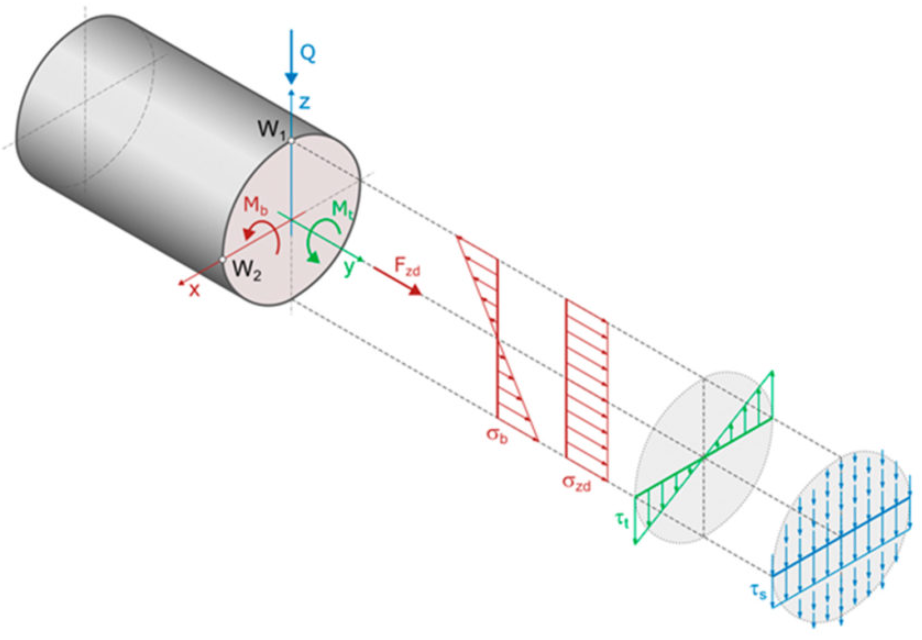Holistic Assessment of Drive Systems with Gears, Shafts and Bearings Using Measured Torque-Speed Data

Verification of a drive system should include all main elements of the system, which are gears, bearings, shafts, and depending on the application other parts such as screws, couplings, and connections. Gears are clearly the most complicated parts for verification, but in many cases, a gearbox failure has its origin in a shaft or bearing failure. The subject of this paper is to explain how verification of a drive system based on measured or simulated torque-speed-time data can be handled. Verification of a gear drive with a reference load/speed can be performed in three ways: Based on a given load and requested lifetime to calculate the corresponding safety factors and compare these factors with a minimum requested safety factor. Such a procedure corresponds to the methods given in most ISO standards (for example in ISO 6336 (Ref. 2) for gears). Based on a given minimum requested safety factors and a requested lifetime to calculate the so-called power rating (or torque rating or transmittable torque). Such a procedure corresponds to the methods given in many AGMA standards (for example in AGMA 2001 [Ref. 4] for gears). Based on a given load and minimum requested safety factors to calculate the achievable lifetime. These variants are not as different as they appear. One variant can easily be transformed into another depending on the required documented result: Achieved safety factors (per A), transmittable power (per B), or achievable lifetime (per C). If the load is derived from measured data (such as time-torque-speed information) or a numerical simulation, then the approach is similar. Such information must be converted into a load spectrum, which can be used for gear calculations according to ISO or AGMA ratings, based on the methods described in ISO 6336-6 (Ref. 3). With load spectrums (or ‘variable load’ termed in ISO), normally variant A is used for verifications, but variant C can also be applied. In this case, the proceeding described in AGMA ratings must be adapted slightly (Ref. 1). If the load definition is given with variable load, then all elements of a drive system having verification methods, such as gears, which consider material strength depending on the number of load cycles (SN-curves), should make use of this information for an appropriate analysis. For other elements (such as screws and feather keys), which are usually checked by a static analysis, only the most critical bin of a load spectrum (the maximum load) will be used. In the next sections, the method of how to generate a load spectrum from time-torque-speed data is discussed. The method used depends on the considered machine element, and therefore is quite different for gears, bearings, and shafts. Then the verification method with variable load will be discussed for the critical elements of drive trains such as gears, bearings, and shafts. Of special interest is the verification of shafts with variable load, because neither ISO nor AGMA have a verification method, only the German FKM guideline has one.
1.The news above mentioned with detailed source are from internet.We are trying our best to assure they are accurate ,timely and safe so as to let bearing users and sellers read more related info.However, it doesn't mean we agree with any point of view referred in above contents and we are not responsible for the authenticity. If you want to publish the news,please note the source and you will be legally responsible for the news published.
2.All news edited and translated by us are specially noted the source"CBCC".
3.For investors,please be cautious for all news.We don't bear any damage brought by late and inaccurate news.
4.If the news we published involves copyright of yours,just let us know.
Next Nord Powers Automation with Modular Solutions for Over 100 Diverse Industries
BRIEF INTRODUCTION
Cnbearing is the No.1 bearing inquiry system and information service in China, dedicated to helping all bearing users and sellers throughout the world.
Cnbearing is supported by China National Bearing Industry Association, whose operation online is charged by China Bearing Unisun Tech. Co., Ltd.
China Bearing Unisun Tech. Co., Ltd owns all the rights. Since 2000, over 3,000 companies have been registered and enjoyed the company' s complete skillful service, which ranking many aspects in bearing industry at home and abroad with the most authority practical devices in China.


